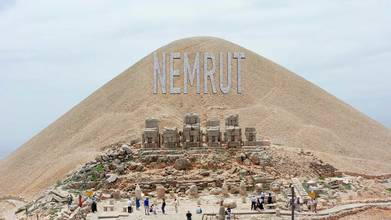
Nemrut - Mountain of Gods - 4K
AIRVŪZ STAFF NOTE :
The mountain of Nemrut (sometimes called Nemrud) in southeastern Turkey is known for its summit, not its peak. The summit has a number of large statues erected around what is generally believed to be a royal tomb from the 1st century BC. At an elevation of around 2.1k meters above sea level (around 7k ft.), it is one of the highest peaks on the eastern side of the Taurus Mountains. See the incredible mountain by drone in this 4K video by pilot jesus_tr. Also, you can read more about the mountain in his informative description.
- about 6 years ago
- 1.6k VŪZ
21 


- 37
- Report
The Mount Nemrut is one the highest peaks of the Mesopotamia, and its summit at 2,206 metres above the sea level contains the tomb of King Antiochus I of Commagene, commissioned by himself. The gigantic statues of gods, each weighing 6 tons and 10 metres tall, indicate what kind of super-human effort was spent on the construction of the tomb. Boulders were the main material used and they were carried up the mountain from the valley below, and similarly the crushed rock pieces used to pile over the main tomb chamber in order to create a 50 ‑metre high cone with 150-metre diameter base were carried the same way. This creative scheme has proven to be effective and prevented grave robbers accessing to the inner sanctum. The tomb chamber is yet to be accessed and the treasures inside are awaiting discovery. However the statues of gods and the sanctuary formed along the three aspects of the tumulus are considered unique, and consequently it was inscribed in the UNESCO List of World Heritage. The mausoleum of Antiochus I (69–34 B.C.), who reigned over Commagene, a kingdom founded north of Syria and the Euphrates after the breakup of Alexander's empire, is one of the most ambitious constructions of the Hellenistic period. The syncretism of its pantheon, and the lineage of its kings, which can be traced back through two sets of legends, Greek and Persian, is evidence of the dual origin of this kingdom's culture.
Up Next
Aerial Views of Mount Nemrut

- AirVūz Editorial
- 940 VŪZ
24 - 9
- about 6 years ago
Nemrut Crater Lake

- Truvali_17
- 1.7k VŪZ
12 - 9
- almost 3 years ago
Garden of the Gods Winter 4K Extended Footage

- davetke2002
- 931 VŪZ
12 - 6
- almost 5 years ago
Mount Ida - 4K

- jesus_tr
- 1.3k VŪZ
12 - 20
- over 6 years ago
Southern Utah’s Valley of the Gods 4K Highlight Reel

- azgeek
- 1.7k VŪZ
31 - 32
- about 8 years ago
The Pinnacle Rock - Gods Window South Africa 4K

- davetke2002
- 729 VŪZ
2 - 1
- over 3 years ago
Olympus: The Mountain of the Gods

- dragonfly
- 2.8k VŪZ
20 - 17
- about 7 years ago
Kula Fairy Chimneys - 4K

- jesus_tr
- 1.1k VŪZ
17 - 22
- over 6 years ago
Lake Salda - 4K

- jesus_tr
- 652 VŪZ
11 - 11
- over 6 years ago
Akdamar Island - 4K

- jesus_tr
- 846 VŪZ
8 - 10
- about 6 years ago


